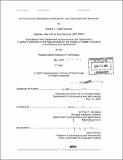Airline revenue management methods for less restricted fare structures
Author(s)
Cléaz-Savoyen, Richard L
DownloadFull printable version (15.51Mb)
Other Contributors
Massachusetts Institute of Technology. Dept. of Aeronautics and Astronautics.
Advisor
Peter P. Belobaba.
Terms of use
Metadata
Show full item recordAbstract
Traditional Revenue Management systems were developed to maximize airlines' revenues in restricted fare product environments, based on the assumption of independence of demand by fare class. With the rapid emergence of low-cost carriers in various parts of the world, the pricing environments have changed. The network carriers have had to deal with undifferentiated fare structures, for which demand for each fare class can no longer be assumed to be independent, given that customers systematically buy the lowest fare available in the absence of distinctions between fare products. In these fare structures, traditional Revenue Management systems lead to a "spiral down" of revenues. The first goal of this thesis is to present two alternatives that address the problem described above, allowing airlines to partially recover from the decrease in revenue which occurs when an airline removes the restrictions in its fare structure. These alternatives are designed for implementation into O&D-Control - or network Revenue Management - methods. The alternative methods are based on the sell-up probability, which is the probability that a passenger is willing to buy a higher-fare ticket in case his/her request is denied. One of the methods ("Q-Forecasting") modifies the forecaster by estimating the demand based on the probability of sell-up, while the other ("Fare Adjustment") acts at the booking limit optimizer level, accounting again for the sell-up potential. (cont.) We focus in this thesis on explaining the processes and mechanisms involved in these two methods, how they are linked and complement each other, but also on their performances based on a simulator which allows us to observe the impact of each method under various characteristics of the booking process.
Description
Thesis (S.M.)--Massachusetts Institute of Technology, Dept. of Aeronautics and Astronautics, 2005. Includes bibliographical references.
Date issued
2005Department
Massachusetts Institute of Technology. Department of Aeronautics and AstronauticsPublisher
Massachusetts Institute of Technology
Keywords
Aeronautics and Astronautics.